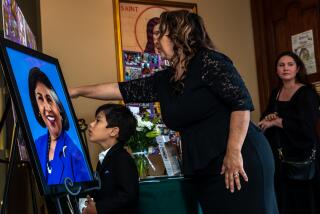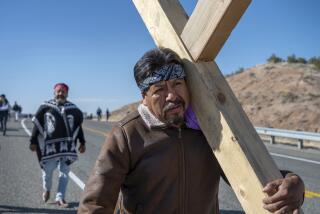Paying Tribute Through Toil
- Share via
CALCUTTA — No one died Saturday at the Sacred Heart Home for Dying Destitutes, which made it a special day. On most days somebody does.
As tens of thousands watched the body of Mother Teresa go to its final resting place after her state funeral, the workers across town in the clinic she built carried on with the work of comforting those on the edge of death.
It was the best way, they said, to honor her memory.
The theme was struck repeatedly throughout the city Saturday as thousands of mourners and dignitaries from around the world bade farewell to the Roman Catholic nun who had served India’s poor for decades. At the funeral Mass, at the burial and at her Missionaries of Charity clinics around Calcutta, those dedicated to her cause promised to carry on with the work.
“Mother is gone, and that is very sad,” said Andy Wimmer, a banker from Germany who quit his job and has spent eight years working at the Sacred Heart Home. “But we will carry on here. Our work will continue.”
With Mother Teresa buried, and the force of her personality gone, the people carrying on with the work of the Missionaries of Charity began confronting a future without her. Some, even in the order, have expressed concern that it will be difficult to raise money without Mother Teresa’s charismatic leadership.
By the looks of things at the Sacred Heart clinic, the legacy of Mother Teresa seemed safe.
Wimmer, 42, tended to the patients even as Mother Teresa’s funeral and burial unfolded. He caught glimpses whenever he passed the television set at one end of the clinic.
The 42 male patients in Wimmer’s charge are spread out across the terrazzo floor on green vinyl stretchers. Most are edging toward death, lying about in a daze or shivering under blankets. About half have tuberculosis, while others suffer from meningitis, elephantiasis or severe burns.
About 45 women stay in an adjoining room.
The clinic, begun by Mother Teresa in 1952, accepts seriously ill patients unable to get care elsewhere. About three patients a day are admitted here. Sometimes they make their own way to the clinic and collapse at the door. Wimmer and the other clinic orderlies regularly search public parks and train stations for the ill and dying. Many of the men in his care had been gnawed and chewed by maggots and rats. Most of the illnesses are worsened by malnutrition.
“It is horrible, the things that we see,” Wimmer said.
Still, Wimmer goes about his tasks like a man happy in his work. He chats with his patients as he stoops to wipe and clean them, ruffles their hair and straightens their pillows.
Some of the patients, like the man in bed No. 36, don’t have very much longer to live.
Wimmer doesn’t know his name, because the man, who is suffering from tuberculosis and is too weak to eat, doesn’t talk. Wimmer found him in the Maidan, Calcutta’s central park, three weeks ago.
“We are providing these people with a little love and a little care,” Wimmer said. “It may be the only love they will ever know.”
Earlier in the day and across the city, the woman assuming leadership over the Missionaries of Charity also had vowed Saturday that the order and its 4,000 nuns will continue to work and thrive.
“We should pledge ourselves to continue what God has begun through [Mother Teresa] so beautifully,” Sister Nirmala told the about 12,000 mourners who gathered at the funeral Mass. “We pray that we may be faithful and truthful to the spirit that God has given to our Mother.”
During the past year, Nirmala said, about 400 new nuns joined the order. They will help run the almost 600 clinics and orphanages that the Missionaries of Charity operate worldwide, which are supported by private donations.
In Calcutta, a city of roughly 13 million, the charity maintains an orphanage, a clinic for lepers, homes for mentally retarded children, and a recently opened home for the children of prostitutes.
Mother Teresa’s body, carried atop a flag-draped carriage, made its final journey Saturday afternoon in the rain to its burial site. Thousands gathered outside, crowding the sidewalks, standing atop buildings, sitting in trees.
Many, like Michael Roy, touched his forehead as Mother Teresa’s body passed, a Hindu gesture blessing the dead.
“Hindu, Christian, it doesn’t matter to me,” said Roy, a baker who stood in the mud as Mother Teresa’s carriage rolled by. “Religion obviously did not make any difference to her.”
A stream of nuns wearing the order’s distinctive white and blue saris followed the casket inside the mission for a private burial. She was lowered into a tomb in the mission’s former dining room, and a volley of shots fired in salute signaled that Mother Teresa’s body had been sealed in its grave.
Shortly after the burial, First Lady Hillary Rodham Clinton met with Sister Nirmala and others from the Missionaries of Charity and urged them to continue their work.
Mrs. Clinton, still wearing black, scooped infants into her arms as she toured the Shishu Bhavan orphanage, just down the street from Mother Teresa’s burial site.
“We wanted to come to Calcutta to express our deep sadness at the passing of Mother Teresa but also to celebrate her mission, her faith and her life,” Mrs. Clinton said.
At the Sacred Heart Home, meanwhile, the grimness of death is sometimes relieved by moments of hope. Three weeks ago, a 21-year-old man known only as Maidick wandered into the clinic. He was near death from meningitis.
Now, he is sitting up in bed and nearly ready to go back to his home on the streets.
Said Wimmer: “This is what keeps us going.”
More to Read
Sign up for Essential California
The most important California stories and recommendations in your inbox every morning.
You may occasionally receive promotional content from the Los Angeles Times.










